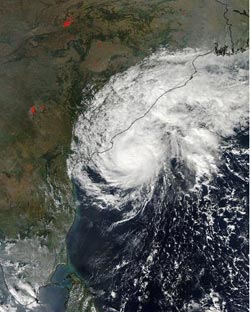NASA sees Tropical Storm Helen affecting southeastern India

On Nov. 21 at 07:55 UTC the MODIS instrument aboard NASA's Aqua satellite captured this visible image of Tropical Cyclone Helen over eastern India.<br><br>Credit: NASA Goddard MODIS Rapid Response Team<br>
On Nov. 21 at 07:55 UTC/2:55 a.m. EDT the MODIS or Moderate Resolution Imaging Spectroradiometer instrument that flies aboard NASA's Aqua satellite captured a visible image of Tropical Cyclone Helen that showed clouds in the storm's western quadrant had already spread over eastern India.
Two minutes before the MODIS instrument captured the visible image of Helen's clouds, the infrared instrument aboard Aqua called the Atmospheric Infrared Sounder or AIRS instrument used infrared light to gather data from the storm. The infrared data showed that the strongest thunderstorms with the coldest cloud top temperatures were still off-shore.
The stretched around the center from northwest to southwest and wrapped around to the east. Only the bands of thunderstorms in the northern quadrant appeared to be fragmented, which could be a result of that area's interaction with land.
On Nov. 21 at 1500 UTC/10 a.m. EST, Tropical Cyclone Helen was located about 495 nautical miles/569.6 miles/ 916.7 km southwest of Calcutta, India, near 16.1 north and 83.0 east. Helen was moving a little faster than the previous day, now at 4 knots/4.6 mph/7.4 kph to the northwest. Helen's maximum sustained winds had increased slightly to 55 knots/63.2 mph/101.9 kph, and those tropical storm force winds extend out 65 nautical miles/74.8 miles/120.4 km from the center. Helen was also creating maximum wave heights of up to 20 feet/6.0 meters, and causing rough seas along the southwestern coast of India.
As a result of the strong waves and tropical-storm force winds, warnings are in effect for Andhra Pradesh that include: A storm surge of 1 to 1.5 meters/3.2 to 4.9 feet will occur at the time of landfall, Thatched roofs and huts will sustain damage and a call for fisheries to cease operations.
Helen is expected to weaken as it nears the coast as it moves into cooler waters and continues to battle moderate wind shear. Helen is expected to make landfall near Tenali early on November 22. After landfall, Helen should weaken as it moves west where it is expected to dissipate in a couple of days.
Media Contact
More Information:
http://www.nasa.govAll latest news from the category: Earth Sciences
Earth Sciences (also referred to as Geosciences), which deals with basic issues surrounding our planet, plays a vital role in the area of energy and raw materials supply.
Earth Sciences comprises subjects such as geology, geography, geological informatics, paleontology, mineralogy, petrography, crystallography, geophysics, geodesy, glaciology, cartography, photogrammetry, meteorology and seismology, early-warning systems, earthquake research and polar research.
Newest articles

Superradiant atoms could push the boundaries of how precisely time can be measured
Superradiant atoms can help us measure time more precisely than ever. In a new study, researchers from the University of Copenhagen present a new method for measuring the time interval,…

Ion thermoelectric conversion devices for near room temperature
The electrode sheet of the thermoelectric device consists of ionic hydrogel, which is sandwiched between the electrodes to form, and the Prussian blue on the electrode undergoes a redox reaction…

Zap Energy achieves 37-million-degree temperatures in a compact device
New publication reports record electron temperatures for a small-scale, sheared-flow-stabilized Z-pinch fusion device. In the nine decades since humans first produced fusion reactions, only a few fusion technologies have demonstrated…





















